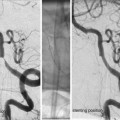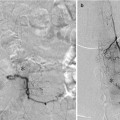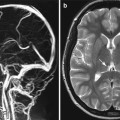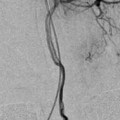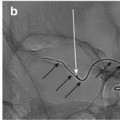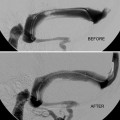Fig. 1
World Health Organization (WHO) Surgical Safety checklist (Adapted for use in the Interventional Neuroradiology Suite, The National Hospital for Neurology and Neurosurgery)
Correct identification of the patient (especially important in those with altered conscious state).
MRSA status.
Baseline creatinine/glomerular filtration rate (GFR) and adherence to precautions recommended by the Royal College of Radiologists.
Pregnancy status.
Medication and allergy history.
Appropriate fasting prior to general anesthesia/sedation (6 h for food and 2 h for clear fluids).
Monitoring for all patients should include:
3-lead ECG, noninvasive blood pressure (BP), pulse oximetry, oxygen (O2) and CO2 analysis, inspired and expired concentration of volatile agent, and ventilator pressure recording (all monitoring equipment should be carefully positioned to avoid obscuring areas being visualized radiographically).
+/− Invasive arterial blood pressure (IABP) monitoring (most interventional procedures require this to provide immediate knowledge of changes in BP and to accurately monitor the response to pharmacological interventions in BP manipulation. Additionally IABP monitoring is useful for arterial blood gas (ABG) analysis, measurement of blood glucose, and monitoring anticoagulation following administration of heparin).
ICP monitoring, if already initiated, should be continued especially if ICP is high as the inability to provide a reverse Trendelenburg position on the angiography table will result in a further increase in ICP.
Central venous monitoring is not usually required but may be useful in the initiation of a triple-H therapy in patients with symptomatic vasospasm.
Core body temperature measurement (i.e., nasopharyngeal).
Induction of Anesthesia
The choice of anesthetic agent is guided primarily by cardiovascular and cerebral considerations.
There is no “recommended” specific anesthetic drug technique.
Total intravenous anesthetic (TIVA) techniques or combinations of inhalational and intravenous (IV) methods are popular choices.
Theoretically N2O should be avoided because of the risk of expanding the volume of microemboli accidently introduced into the cerebral circulation through arterial flushing devices. There is no evidence to support this.
Anesthesia should follow the general principles of neuroanesthesia and provide smooth induction with cardiovascular stability, avoidance of pressor response to laryngoscopy, etc.
Intra-procedural BP should be tailored to the individual patient based on preoperative baseline values (especially in hypertensive patients who should be assumed to have right shift of the cerebral autoregulation curve) and adjusted for specific conditions:
For unprotected cerebral aneurysms, a systolic BP <160 mmHg (mean arterial pressure <110 mmHg) and the avoidance of hypotension are recommended.
For hyperacute stroke patients (presenting for endovascular treatment following intravenous thrombolysis), a systolic BP target of <185 mmHg and a diastolic BP <110 mmHg are required. High pressures are usually centrally driven to maintain a vital collateral circulation.
Maintenance of normoxia (PaO2 of 13 kPa or SpO2 between 94 and 98 % in acute situations where hyperoxia injury is a potential complication).
Maintenance of normocapnia (PaCO2 between 4.5 and 5.0 kPa) to regulate intracranial pressures.
Maintenance of normoglycemia (5–9.5 mmol/l).
Maintenance of normothermia (avoid hyperthermia which is associated with worse outcomes).
It is advisable to intubate all patients undergoing interventional procedures with a tracheal tube (TT):
This is the most reliable method of controlling the airway for ventilated patients.
This secures the airway especially if the patient requires emergency transfer to theatre for treatment of a complication arising during an INR procedure.
Avoid using reinforced TTs for spinal angiography as the metallic spiral reinforcement may obscure spinal vessels. Additionally reinforced TTs will need to be changed if a post-procedural MRI scan is required.
Secure intravenous (iv) access is essential:
With adequate extension tubing to allow drug and fluid administration at maximal distance from the image intensifier and an easily accessible injection port.
One IV line should be of “large-bore” calibre to allow rapid administration of fluids/drugs if necessary.
A fine-bore nasogastric feeding tube is often required to administer loading doses of antiplatelet drugs (aspirin and/or clopidogrel) for some INR procedures. Usually inserted at induction under direct vision and imaged by the radiologist to confirm position in the stomach before use.
Bladder catheters are required for most procedures:
They assist in fluid management.
Useful to manage high urine output because of osmotic diuresis caused by contrast agent and high volumes of saline flush used to prevent clot formation in arterial catheters.
Positioning and Care of Patient
Monitoring to be attached before transfer to angiography table.
Head and neck in neutral position with no rotation; straight alignment of spinal column.
Protection of eyes (taping).
Careful positioning to prevent pressure areas developing during long procedures; pillow under knees to limit extension of lumbar spine.
Mechanical thromboprophylaxis should be considered (graduated compression stockings and intermittent calf compression) for all patients.
Maintenance of normothermia (warming of IV fluids and forced air warming blanket).
Perform “on table” baseline investigations, i.e., ABG, activated clotting time (ACT), and platelet function, as appropriate.
EVD (when present) should be firmly secured to prevent accidental removal by moving equipment, zeroed and opened at the predetermined height to allow drainage. Personnel must be warned not to alter the angiography table height without liaising with anesthetist.
Stay updated, free articles. Join our Telegram channel

Full access? Get Clinical Tree



